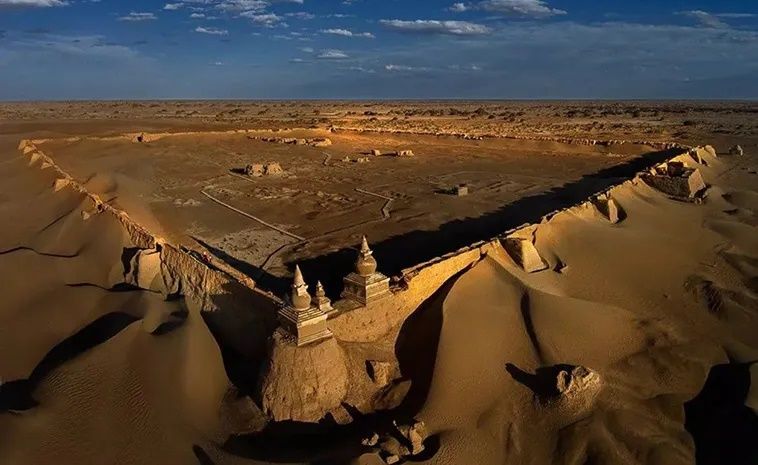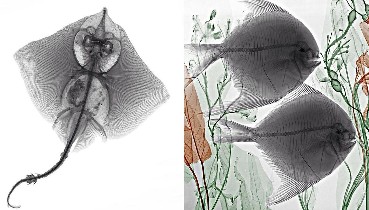

Khara-Khoto: Abandoned Ancient Mongolian ‘Black City’
Khara-Khoto, also known as Black City or Black Fortress, was a city located in the western part of Inner Mongolia, China. Built in 1032, the city thrived under the rule of the Western Xia dynasty, or known as the Tangut Empire, as an important center for trade and culture along the Silk Road. Khara-Khoto was inhabited by various ethnic groups including Han Chinese, Uighurs, and Mongols.

The city was captured by Genghis Kahn in 1226, but instead of laying to waste as the Khan’s Golden Horde usually did to captured cities, Khara-Khoto actually flourished under Mongol rule. During Kublai Khan’s time, the city expanded to three times its original size, and was even mentioned by Marco Polo in his travelogue by its Tangut name of Etzina: When you leave the city of Campichu you ride for twelve days, and then reach a city called Etzina, which is towards the north on the verge of the Sandy Desert; it belongs to the Province of Tangut. The people are Idolaters, and possess plenty of camels and cattle, and the country produces a number of good falcons, both Sakers and Lanners. The inhabitants live by their cultivation and their cattle, for they have no trade. At this city you must needs lay in victuals for forty days, because when you quit Etzina, you enter on a desert which extends forty days’ journey to the north, and on which you meet with no habitation nor baiting-place.

According to one of the many Mongolian legends, in the late 14th century AD, the Mongol ruler Khara Bator was surrounded in Khara-Khoto by the armies of China’s Ming dynasty who diverted the waters of the Ejin River that fed the city’s water supply. As the inhabitant’s thirst grew deadly, Khara Bator recognised his fate, and insane with fury he murdered his family—then turned his sword upon himself and committed suicide. After the city was taken, Khara-Khoto was abandoned and swallowed by the sands of the Gobi Desert until it was rediscovered in the early 20th century.

The site was rediscovered in the early 20th century by a Mongol-Sichuan expedition under the command of Russian explorer Pyotr Kuzmich Kozlov. During its initial excavation, the expedition uncovered over 2,000 books, scrolls, and manuscripts in the Tangut language. These treasures were sent back to St. Petersburg along with Buddhist statues, texts, and woodcuts that were found in a stupa outside of the city walls. Further excavation produced many thousand more manuscripts, books, as well as daily items, production instruments, and religious art. Many of these books and xylographs formed the basis for research of the Tangut language, written in Tangut script in subsequent years.

Now all that remains of this great city are 30-feet-tall ramparts, a few 40-feet high pagodas, and what appears to be a mosque just outside the city walls, indicating that there were Muslims among the people that were ruled by the Tangut. Today, Khara-Khoto is recognized as a UNESCO World Heritage Site, preserving its legacy as an important cultural and economic center of medieval China. Ongoing archaeological research continues to unravel the mysteries of this ancient city, offering glimpses into the lives of its inhabitants and their interactions with the wider world.



Now all that remains of Khara-Khoto are 30-feet-tall ramparts, a few 40-feet high pagodas, and what appears to be a mosque just outside the city walls

Recommended Videos
 It’s Been A While Since We Checked In On The Fine People Of Walmart (50 Pics)...5881 views
It’s Been A While Since We Checked In On The Fine People Of Walmart (50 Pics)...5881 views 89 Of The Cutest Cat Pics From Around The Internet1349 views
89 Of The Cutest Cat Pics From Around The Internet1349 views-
Advertisements
 This Waterbird Has Unique Feet That Look Like Feathers, And The Photos Are Awesome!214 views
This Waterbird Has Unique Feet That Look Like Feathers, And The Photos Are Awesome!214 views 9,500-Year-Old Tree Found in Sweden Is The World’s Oldest Tree145 views
9,500-Year-Old Tree Found in Sweden Is The World’s Oldest Tree145 views 30 MOST FAMOUS PLUS-SIZE MODELS IN THE WORLD8340 views
30 MOST FAMOUS PLUS-SIZE MODELS IN THE WORLD8340 views 101 Who Wore It Better?” Pics That Will Make You Laugh Out Loud”15711 views
101 Who Wore It Better?” Pics That Will Make You Laugh Out Loud”15711 views 40 Vintage Postcards of Mid-Century Romantic Couples819 views
40 Vintage Postcards of Mid-Century Romantic Couples819 views Pilosocereus leucocephalus (Old man cactus).278 views
Pilosocereus leucocephalus (Old man cactus).278 views



